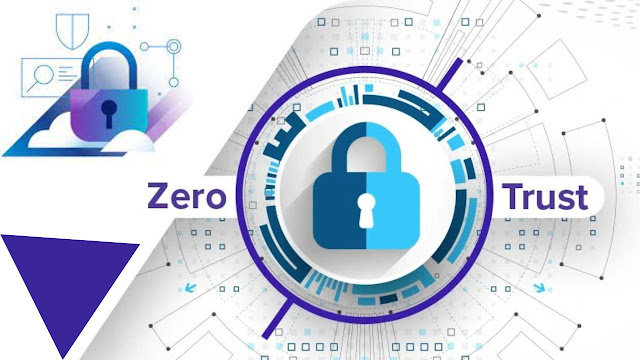In the modern, digitally linked world, vital infrastructure
plays an essential part in determining the level of a nation's economy as well
as its level of security. On the other hand, since the degree of difficulty and
frequency of cyber attacks continues to rise, it is more important than ever to
implement stringent security measures. Zero Trust emerges as a game-changing
strategy that poses a challenge to the traditional perimeter-based security
models and provides a new framework for the purpose of protecting the most
important assets of our country. As professionals in the area of cybersecurity,
we are going to examine the idea of Zero Trust and the role that it plays in
ensuring the safety of the future of our country in this in-depth piece that we
have written.
Comprehending the Concept of Zero Trust
At its foundation, Zero Trust is a security architecture
that adheres to the credo "never trust, always verify." Zero Trust
takes a proactive attitude by considering any person, device, or program that
attempts to access key infrastructure as if they are possible threats. This is
in contrast to standard security models, which presume that everything that is
contained inside the network is secure. Zero Trust limits the attack surface
and the danger of unauthorized access by continually verifying and approving
people and devices. This reduces the likelihood of unwanted access.
The Foundational Principles of "Zero Trust"
To have a complete understanding of the effectiveness of
Zero Trust, it is necessary to appreciate its basic principles, which serve as
the basis for this ground-breaking security strategy:
1. The practice of micro-segmentation
Micro-segmentation is the process of splitting a network
into smaller pieces that are separated from one another. This enables
businesses to implement stringent access restrictions and stops lateral
movement inside the network. With Zero Trust, critical data and applications
are kept in separate compartments, so if one component of the infrastructure is
compromised, it won't affect the rest of the infrastructure.
2. Multi-Factor Authentication (often referred to as MFA)
One of the most important aspects of Zero Trust is the use
of Multi-Factor Authentication. Before getting access to the network or
sensitive information, it is necessary for users to first submit a number of
different forms of identity. This considerably improves the security of the
system because even if one of the authentication factors is breached, the other
levels of authentication will function as a deterrent to any possible cyber
attackers.
3. Access with the Fewest Privileges
The Zero Trust model adheres to the notion of giving users
just the level of permission that is required for them to do their work. The
danger of unauthorized access may be greatly reduced if access privileges are
whittled down to the absolute minimum that is necessary for certain jobs.
4. Ongoing Observation and Analytical Procedures
Monitoring in real-time and using sophisticated analytics
are two crucial components of Zero Trust's success. It is possible to detect
potentially malicious behaviors in a timely manner by continually monitoring
user behavior, devices, and network traffic. This enables a speedy reaction and
repair.
Putting into practice a policy of zero trust for critical infrastructure
It is necessary to take a methodical and well-orchestrated
strategy in order to successfully deploy Zero Trust for the purpose of
protecting critical infrastructure. In the following, we will walk you through
the process of adopting the Zero Trust principles in your organization:
Step 1: Comprehensive Risk Evaluation.
Before beginning the road to Zero Trust, companies are
required to undertake a thorough risk assessment in order to identify possible
weak spots and dangers. This examination has to include every facet of the
infrastructure, from its physical and digital assets to its user access levels
and its network architecture.
Step 2: Map out the data flows and dependencies.
When it comes to developing efficient micro-segmentation
methods, having a solid understanding of the data flows and connections is very
necessary. In order to figure out the most effective approach to organize their
micro-segmentation rules, businesses need to first map the flow of data across
their networks and then assess which dependencies are mission-critical.
Step 3: Developing a Zero Trust Architecture.
The risk assessment and data mapping should provide the
basis for businesses developing a comprehensive Zero Trust architecture that is
customized to meet their particular requirements. In order to create a unified
security ecosystem, this architecture should include multi-factor
authentication (MFA), access with the fewest privileges possible, continuous
monitoring, and analytics.
Step 4: Performing Test Runs and Pilot Projects.
Before deploying Zero Trust throughout the whole of an
organization's infrastructure, firms should first undertake pilot testing in
controlled conditions to evaluate its efficacy and identify possible
difficulties. Continuous testing and simulations provide the means for the Zero
Trust model to be fine-tuned and optimized.
Step 5: Ongoing Instruction and Continual Awareness
Education and awareness are very necessary components for
the effective implementation of zero trust. Continuous training programs are
something that organizations need to invest in if they want to guarantee that
all of their staff members grasp the Zero Trust security principles and best
practices.
Step 6: Integration with Preexisting Systems.
To achieve a smooth transition and minimize interruptions,
the deployment of Zero Trust should be done in such a way that it is easily
integrated with any current security systems and protocols.
The Effects of Complete Lack of Trust on the Safety of the Country
The implementation of zero trust for the purpose of
protecting vital infrastructure may have far-reaching effects on the nation's
security in the following ways:
1. Resistance to Attacks Performed Via the Internet
Countries have the potential to greatly improve their
resistance to cyber assaults if they embrace the Zero Trust model. The
preventative method of ensuring data security reduces the likelihood that
sensitive information will be compromised and lessens the damage that may be
caused by any prospective assaults.
2. The Safeguarding of Crucial Assets
A nation's economy and overall well-being are supported by
the country's critical infrastructure, which includes electricity grids,
banking systems, and transportation networks, among other things. The use of
Zero Trust protects the security of these essential assets from cyber attacks,
external adversaries, and internal saboteurs by using a trust model that does
not exist.
3. Establishing Trust with Local Residents
Zero trust not only protects infrastructure from outside
dangers but also increases residents' levels of confidence in their government.
When citizens in a country feel that their government is taking cybersecurity
seriously, it instills trust and comfort in the nation's overall safety and
stability.
Conclusion:
In conclusion, adopting a policy of zero trust is absolutely
necessary in order to ensure the continued safety of the essential
infrastructure of our country. Because it takes a preventative and
all-encompassing approach to security, it can ward off potential cyberattacks
and protect the most important of our assets. As professionals in the field of
cybersecurity, we are strong proponents of incorporating Zero Trust into the
overall security policy of our country as an essential component.
Read more: Zero Trust The Go-To Guide for Online Safety







0 Comments